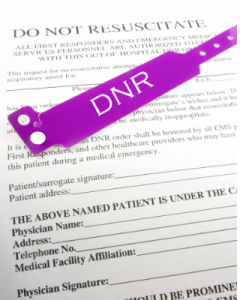
Advance Directives
Updated: August 7, 2023
After you have had the “Conversation,” you should immediately proceed with creating a plan and documenting it in the form of an advance directive (AD). An AD is a legal document that answers the “what if” questions and is meant to guide family and healthcare professionals to provide the care you would or would not prefer in urgent medical situations when you are unable to give consent. You must be at least 18 years old to create one.

Advance directives include important information about your treatment preferences for critical end-of-life medical care. In addition, an advance directive could significantly reduce any anxiety, indecisiveness, and guilt loved ones may have from needing to make decisions without this guidance from you. A prior discussion could aid the healthcare proxy in making the decision most appropriate for you.
As with any legal document, it must be done correctly and the court can have the final say on whether it is valid or not. Laws about advance directives are present in the 1990 Patient Self Determination Act.
Most states allow you to create out-of-hospital advance directives, including living wills, Physician Orders for Life-Sustaining Treatment (POLST), and Do-Not-Resuscitate (DNR) orders and healthcare proxies. However, there is variation in the name and content of the documents used, who is involved in creating and certifying them, how strictly they are enforced, where they can be placed, etc. Some states require you to renew your living will on a regular basis. If so, you need to know how often that is and what you need to do.
Your choice of a healthcare proxy or healthcare power of attorney should be considered at the same time as your advance directive. This could either be a separate document or combined with the Living Will. Desire to become an organ donor is sometimes considered an advance directive, but is usually a separate document. The directives will apply whether you are in the hospital or elsewhere.
If advance directives are not available, decisions will usually be made by substituted judgment (what the patient would most likely choose) and/or best interest (what is best for the patient when choices are not known).
Another consideration if you do not have these documents is that not all states will appoint family members to be your healthcare surrogate and allow them to make medical decisions if you are incapacitated and mentally incompetent. Some states may require clear evidence of your wishes if you do not have a designated healthcare proxy and a family member is named as your healthcare surrogate.
Once you have created these documents, store them in an accessible computer or physical file. Make multiple copies and distribute them to any healthcare professional involved in your care and any family member or other persons who may possibly be in a position to make an emergency medical decision. It is important for you to place them in your medical record and put others in obvious locations in your house for emergency responders to see.
- POLST documents and DNR orders placed in your home should be printed on brightly-colored paper and displayed where emergency medical personnel can easily see them.
- You can get a medical alert wallet card, necklace, or bracelet for when you are not at home.
- When you are in the hospital, your healthcare provider can put an order in your inpatient medical chart that these directives be honored, but that will only apply to that hospitalization. If your primary healthcare provider is not taking care of you, the inpatient provider will need to see copies of the documents.
Use a legal professional or be sure to use state-specific laws and documents.
Although advanced directives are optional, the 1990 Patient Self-Determination Act requires hospitals, skilled nursing facilities, home health agencies, hospice programs, and health maintenance organizations to ask patients if they have an advance directive, recognize them if they do, or provide information about advance directives in their state if they don’t.
Like every aspect of advance care planning, these documents are best created when you are younger and, more importantly, before a crisis situation prevents you from doing so. They should be updated as circumstances change and can be revoked at any time.
It is best if you check in with your family and healthcare provider before you put these directives in place. The process could bring out any hidden concerns and clarify any misunderstandings you may have about specific medical conditions or interventions.
Living Will/Advance Care Plan
This is a legally binding document that describes your wishes, typically for medical care, to ensure that everyone, especially your Healthcare Proxy, is aware of them in the hope that they are carried out exactly as you would want when you are terminally ill or permanently unconscious. It only goes into effect if at least one, but usually two, doctors deem you both incapacitated and mentally incompetent, such as with severe dementia, or otherwise unable to speak or communicate on your own behalf.

As long as you can make requests, your word gives consent despite what is in your living will. If you are only temporarily unable to communicate, your healthcare proxy may speak for you without resorting to the living will, but they should use it as a guideline.
A living will will only be used by your healthcare providers, your healthcare proxy, and family if you are unable to make medical decisions.
- It will take effect when you:
- Are in a coma, such as from a stroke, tumor, or other brain injury;
- Have advanced Alzheimer’s or dementia; and/or
- Have other complications of an illness that make it impossible to communicate.
- It is your opportunity to spell out exactly what medical care/intervention you want or don’t want in specific situations, such as serious illness or when approaching the end of life.
- This can prevent expensive care your family may want to request, but you wouldn’t want, such as:
- Further treatment and/or testing;
- Life sustaining care when there is no hope of recovery; and/or
- Resuscitation after you have died.
- Your healthcare proxy/healthcare power of attorney will be responsible for all specific decisions about your care based on your requests.
- Some states allow you to designate this person in the living will; others require a separate document.
- Despite being a legally binding document, your proxy may not always honor your request.
- You may also need to file a Health Insurance Portability and Accountability Act (HIPAA) release form with all of your doctors to specify who you would like your medical information to be shared with, including your healthcare proxy.
- You should ask for your primary healthcare provider’s help in making your POLST.
 Although it is not possible to anticipate every scenario, try and make the living will as comprehensive as possible. There are many things that are commonly considered, although most situations will not come up until the appropriate time or not at all. To begin, you should consider what you value most about your life, what you hope for most regarding your death, and how it may affect your preferences. Specific things to consider are, if you would want:
Although it is not possible to anticipate every scenario, try and make the living will as comprehensive as possible. There are many things that are commonly considered, although most situations will not come up until the appropriate time or not at all. To begin, you should consider what you value most about your life, what you hope for most regarding your death, and how it may affect your preferences. Specific things to consider are, if you would want:
- To do every possible treatment if you were diagnosed with a terminal illness, realizing that some could negatively affect your quality of life, or just be made comfortable by managing your symptoms;
- To stop curative efforts if they were not working or life-sustaining treatment if there was little hope for recovery;
- Artificial nutrition and hydration by tube or IV if you were unable to eat or drink due to a terminal illness, even if it could cause complications and only help you live longer in discomfort;
- Cardiopulmonary Resuscitation (CPR) if your heart stopped as a result of a serious or terminal illness, knowing it could result in broken bones, collapsed lung, or other medical problems, and is rarely successful in an out-of-hospital situation;
- Mechanical ventilation if you could not breathe on your own and under what circumstances, such as any chance of recovery;
- Defibrillation or heart stimulating drugs if your heart slows down or stops;
- To continue dialysis toward the end;
- To avoid an extended hospitalization or stay in a nursing home;
- To be with your family and/or be at home when you die;
- To be pain free even if it meant trading comfort for wakefulness or alertness or tolerate an acceptable level of pain to be aware of those around you;
- To entrust decisions regarding your care to others, what decisions, and who that will be;
- A funeral, memorial service, or obituary and what they would be like;
- Your body to be buried, cremated, donated to science; and/or
- Any organs donated to help others.
To create a living will you can go to an attorney or you can download your state’s Living Will or Advance Healthcare Directive form, fill it out as directed, and sign it. You will either need your living will:
- Signed by one or two witnesses, depending on your state, at least 18 years old who are not a close relative of the a person chosen as Healthcare Proxy; and/or
- Officially notarized, which may be done at your attorney’s or other Notary’s office or at a local post office, bank, or government office.
Once it is created, the advance directive should be printed out and stored in an obvious location — not a locked safe or safety deposit box — as well as shared with your family, friends, legal representative, and any healthcare provider closely involved in your medical care. Copies of the advance directive given to your agents are just as acceptable as the original.
While you can use your living will to express all of your wishes about any future medical care, many people also create specific documents for life-sustaining treatment and resuscitation.
Resources
- Advance Care Planning Resources – polst.org website
- Advance Directive – everplans website.
- Advance Directives – National Hospice and Palliative Care Organization.
- Creating An Advanced Health Care Directive. everplans website.
- Five Wishes. Aging with Dignity.
- Tool Kit for Health Care Advance Planning – American Bar Association website.
Hannibal B. How to Write a Living Will. NOLO website.
Advance Directive/Advance Care Plan/Living Will forms
- 50 Free Living Will Templates & Forms – Template Lab website.
- Advance Directive forms – AARP website.
- Advance Directives and Living Wills: State-Specific Forms – Find Law website.
- Five Wishes – Aging with Dignity website.
- Living Will forms – legalzoom website.
- Living Will Forms (Advance Directive) by State – eforms website.
- Make Your Free Living Will – Rocket Lawyer website.
- State-by-State Advance Directive Forms – everplans website.
- State-Specific Advance Planning Forms – American Bar Association.
The Physician Orders for Life Sustaining Treatment (POLST)
The POLST, or state-specific equivalent (MOST [Medical Orders for Scope of Treatment], MOLST [Medical Orders for Life Sustaining Treatment], POST [Physician Orders for Scope of Treatment], or TPOPP [Transportable Physician Orders for Patient Preferences]), is a separate legal document that is specific to life-threatening situations. Unlike a living will, which only contains requests, a POLST contains physician orders that other healthcare professionals must honor.
 The document must be filled out by your primary practitioner. They will determine if a POLST is appropriate for you, usually if you’re terminally ill or extremely elderly and frail and are mentally capable of making such a request. Your healthcare proxy can also request one to be filled out for you. Many states prohibit POLSTs for otherwise healthy people. Healthcare providers rarely, if ever, will sign them under these circumstances, since the chance of these measures saving your life is too high.
The document must be filled out by your primary practitioner. They will determine if a POLST is appropriate for you, usually if you’re terminally ill or extremely elderly and frail and are mentally capable of making such a request. Your healthcare proxy can also request one to be filled out for you. Many states prohibit POLSTs for otherwise healthy people. Healthcare providers rarely, if ever, will sign them under these circumstances, since the chance of these measures saving your life is too high.
For when you are in cardiac arrest and not breathing, you can specify the more specific Do-Not-Resuscitate (DNR) order described below.
POLSTs are usually printed on bright-colored paper to be easily spotted. Some states specify the color so EMTs know what to look for.
The POLST should specify what life-saving or resuscitation measures, if any, may be used by responding healthcare providers if you are seriously ill, under what circumstances, and whether or not you want to go to a hospital or be put in an Intensive Care Unit (ICU). You should also express your wishes about life-sustaining treatments if you are at risk of dying with little to no hope of recovery. Measures you should think about include:
- CPR if your heart has slowed down or stopped, which can cause heart and lung damage, and fractures of the ribs and sternum;
- Defibrillation if you have ventricular fibrillation, which can cause chest wall and heart damage;
- Intubation and artificial ventilation (breathing machine), which could result in lung and vocal cord damage and increases the risk of lung infection;
- Heart-supporting drugs, antibiotics, or other medications, which have many complications and side-effects;
- Artificial nutrition and hydration by tube or IV, which could unnecessarily prolong life without improving quality of life and even cause infections, liver damage, gastrointestinal damage, aspiration pneumonia, and kidney problems;
- Blood transfusions, which can cause blood type reactions and rarely transmit infections; and/or
- Dialysis, which is uncomfortable, causes low blood pressure, increases the risk of infection, and unnecessarily prolongs life while reducing quality of life.
You can state your preference about other aspects of care such as not drawing blood, comfort care only, no transfers to acute care facilities, or no vital signs.
For information about programs in individual states see the National POLST Paradigm Program Designations website.
POLST forms
- State-by-State POLST Forms. everplans website.
- Orders for Life Sustaining Treatment forms (MOLST, POLST) – polst.org website
Do-Not-Resuscitate (DNR) order

This is similar to the POLST, but only applies if you are found unresponsive without breathing and/or heartbeat. Like a POLST, you can include the DNR order in your living will and it must be signed by you and your physician, may be restricted to when you’re terminally ill or extremely elderly and frail, and mentally are capable of making such a request. In some states you may need witnesses or a notary.
Without a DNR, emergency responders and healthcare professionals are obliged to do everything possible to revive you. This may include chest compressions, intubation and ventilation, electric shock, and heart stimulating drugs.
While there may be instances where CPR is appropriate, it is rarely successful outside of a hospital setting, can result in broken ribs or other trauma, and is not really meant to try and postpone a terminal event.
- You may want to have a DNR order if you have specific wishes about your end-of-life care, are ready for a natural death, have a terminal or critical illness, or are at significant risk for cardiac or respiratory arrest and don’t want these measures taken.
- These may not honored by EMTs in certain situations, for example CPR may be done if your body is warm or the event was witnessed.
- DNR orders can be suspended or changed during surgery at your or your healthcare proxy’s request.
- Many of the medications used during anesthesia and surgery can increase the risk of cardiac arrest and can be stopped or the effects reversed if this occurs.
- More than half of the resuscitations done during surgery are successful and over 90% are successful if caused by something done during surgery.
- You can be specific about what can be done, for example you can suspend everything but chest compressions or specify that you can only be resuscitated if your cardiac arrest was due to anesthesia.
Unlike a POLST order, a DNR may not always be honored by all EMTs, and they are not available in all states. It is also possible that a state will not honor DNR orders from other states.
Check the laws in your state. Although it is always a good idea to print DNR orders on bright-colored paper to be easily spotter, some states may require specific color forms so EMTs know what to look for. Many states require that any at-home deaths be reported to the authorities via a service such as 911 or the police.
Resources
- Do Not Resuscitate Order (DNR) Cheat Sheet. everplans website.
- How To Create A Do Not Resuscitate Order (DNR). everplans website.
DNR order forms
- Do Not Resuscitate (DNR) Order Forms – eforms
- Do Not Resuscitate (DNR) Form– Legal Templates website
Place Them Where They Are Visible
Copies of advance directives, POLST form, and DNR order should be printed on brightly-colored paper and displayed in an obvious location, such as the refrigerator, where EMTs or other first responders can find them. You can get a wallet card, necklace, or bracelet for when you are not at home.
Resources
- ABC news video – Advance directives assist in end-of-life care.
- Communicating End-of-Life Wishes. National Hospice and Palliative Care Organization.
- End-of-Life Decisions. National Hospice and Palliative Care Organization.
- National Hospice and Palliative Care Organization video – Advance Care Planning.
- Starting the Conversation. Hospice Foundation of America.
- Understanding Advance Directives. National Hospice and Palliative Care Organization.
- Advance Care Planning. American Medical Association website. Accessed: August 7, 2023.
- Advance Care Planning: Healthcare Directives. National Institute on Aging website. Reviewed: October 31, 2022. Accessed: August 7, 2023.
- Advance Directives. American Cancer Society website. Updated: August 13 2021. Accessed: August 7, 2023.
- Advance Directives. American Medical Association website. Accessed: August 7, 2023.
- Advance Directive Cheat Sheet: Five Tips To Get You Started. everplans website. Accessed: August 8, 2022.
- All You Need To Know About Advance Directives. everplans website. Accessed: August 7, 2023
- Botek A. Things You Can and Can’t Do With Power of Attorney. Aging Care website. Updated: November 18, 2022. Accessed: August 7, 2023.
- Do Not Resuscitate (DNR) and POLST. Compassion & Choices website. Accessed: August 7, 2023.
- End-of-Life Care for People With Dementia. National Institute on Aging website. Updated: January 31, 2022. Accessed: August 7, 2023.
- Getting Your Affairs in Order. National Institute on Aging website. Reviewed: February 1, 2023. Accessed: August 7, 2023.
- Give Peace of Mind: Advance Care Planning. The Center for Disease Control website. Reviewed: April 30, 2018. Accessed: August 7, 2023.
- How To Evaluate Life Support Treatments And What They’ll Do To Your Body. everplans website. Accessed: August 7, 2023.
- Irving S. Do-Not-Resuscitate Orders. NOLO website. Accessed: August 7, 2023.
- Irving S. Living Wills and Powers of Attorney for Health Care. NOLO website. Accessed: August 7, 2023.
- Irving S. What Do a Living Will and Power of Attorney for Health Care Cover? NOLO website. Accessed: August 7, 2023.
- Kaminski M. The DNR Form: What is the Role of a Do-Not-Resuscitate Form? legalzoom website. Updated: May 11, 2023. Accessed: August 7, 2023.
- Landefeld J, Incze M. Advance Care Planning-What Should I Know? JAMA Intern Med. 2020;180(1):172.
- Legal and Financial Planning for People with Alzheimer’s. National Institute on Aging website. Reviewed: October 29, 2020. Accessed: August 7, 2023.
- Living Wills, Health Care Proxies, & Advance Health Care Directives. American Bar Association website. Accessed: August 7, 2023.
- Lo B. DNR in the OR and Afterwards. Patient Safety Network website. Published: September 2006. Accessed: August 7, 2023.
- Medically Ineffective Interventions. American Medical Association website. Accessed: August 7, 2023.
- Orders Not to Attempt Resuscitation (DNAR). American Medical Association website. Accessed: August 7, 2023.
- Overview of living wills, health care proxies, advance directives, and powers of attorney. Medicare Interactive website. Accessed: August 7, 2023.
- POLST & Advance Directives. National POLST Paradigm website. Accessed: August 7, 2023.
- Singleton A. Caregiving Conversations to Have With Your Loved Ones in Sickness and in Health. AARP website. Updated: November 29, 2022. Accessed: December 7, 2023.
- Shaw G. Advance Directives. WedMD. Updated: February 5, 2022. Accessed: August 7, 2023.
- Srakocic S. What Is an Advance Directive? Healthline website. Posted: April 28, 2022. Accessed: August 7, 2023.
- Types of advance directives. FreeWill website. Updated: August 11, 2021. Accessed: August 7, 2023.
- Using End-of-Life Services. National Care Planning Council website. Accessed: August 7, 2023.
- What is a Living Will? All Law website. Accessed: August 7, 2023.
- What Is a Living Will and Why Do Seniors Need One. Daily Caring website. Accessed: August 7, 2023.
- What You Need To Know About Creating A Living Will, everplans website. Accessed: August 7, 2023.
- What’s A POLST (Physicians Orders For Life Sustaining Treatment)? everplans website. Accessed: August 7, 2023.
